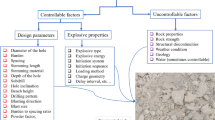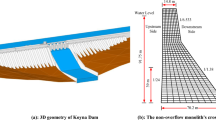Abstract
In the present time, the contribution of underground pipelines is of great significance. Considering the importance of underground pipelines and their susceptibility to explosion, the damage prediction and safety of buried pipelines have become very crucial. This study presents the development of artificial intelligence (AI) models to accurately predict damage in underground steel pipelines subjected to blast loading. For the development of AI models, hundreds of blast simulations were performed in ABAQUS/Explicit using Combined Eulerian–Lagrangian (CEL) approach. The overall efficiency of the developed artificial intelligence (AI) models was evaluated by analysing a set of performance indicators. Among the proposed models, artificial neural network exhibited the best performance in predicting the damage in pipeline. As a contribution, this study proposed an effective learning model for damage prediction in buried pipelines subjected to subsurface blast. Results from this study can facilitate designers in computing damage and also in enhancing the impact behaviour, serviceability, and safety of pipelines.



















Similar content being viewed by others
References
Pichler, B.; Hellmich, C.; Mang, H.A.; Eberhardsteiner, J.: Loading of a gravel-buried steel pipe subjected to rockfall. J. Geotech. Geoenviron. Eng. 132(11), 1465–1473 (2006)
Yang, J.L.; Lu, G.Y.; Yu, T.X.; Reid, S.R.: Experimental study and numerical simulation of pipe-on-pipe impact. Int. J. Impact Eng 36(10–11), 1259–1268 (2009)
Tafreshi, S.M.; Khalaj, O.: Analysis of repeated-load laboratory tests on buried plastic pipes in sand. Soil Dyn. Earthq. Eng. 31(1), 1–15 (2011)
Guan, X.; Wang, X.; Zhu, Z.; Zhang, L.; Fu, H.: Ground vibration test and dynamic response of horseshoe-shaped pipeline during tunnel blasting excavation in pebbly sandy soil. Geotech. Geol. Eng. 38(4), 3725–3736 (2020)
Tang, Q.; Jiang, N.; Yao, Y.; Zhou, C.; Wu, T.: Experimental investigation on response characteristics of buried pipelines under surface explosion load. Int. J. Press. Vessels Pip. 183, 104101 (2020)
Rajput, A.; Iqbal, M.A.; Gupta, N.K.: Ballistic performances of concrete targets subjected to long projectile impact. Thin-Walled Struct. 126, 171–181 (2018)
Rajput, A.; Iqbal, M.A.: Impact behavior of plain, reinforced and prestressed concrete targets. Mater. Des. 114, 459–474 (2017)
Rajput, A.; Iqbal, M.A.: Ballistic performance of plain, reinforced and pre-stressed concrete slabs under normal impact by an ogival-nosed projectile. Int. J. Impact Eng 110, 57–71 (2017)
Iqbal, M.A.; Diwakar, A.; Rajput, A.; Gupta, N.K.: Influence of projectile shape and incidence angle on the ballistic limit and failure mechanism of thick steel plates. Theoret. Appl. Fract. Mech. 62, 40–53 (2012)
Kaushik, A.; Patnaik, G.; Rajput, A.; Prakash, G.: Nonlinear behaviour of concrete under low-velocity impact by using a damaged plasticity model. Iran. J. Sci. Technol. Trans. Civ. Eng. (2022). https://doi.org/10.1007/s40996-021-00808-3
Shi, C.; Zhao, Q.; Lei, M.; Peng, M.: Vibration velocity control standard of buried pipeline under blast loading of adjacent tunnel. Soils Found. 59(6), 2195–2205 (2019)
Sklavounos, S.; Rigas, F.: Estimation of safety distances in the vicinity of fuel gas pipelines. J. Loss Prev. Process Ind. 19(1), 24–31 (2006)
Tao, M.; Li, X.; Wu, C.: 3D numerical model for dynamic loading-induced multiple fracture zones around underground cavity faces. Comput. Geotech. 54, 33–45 (2013)
Du, Y.; Ma, L.; Zheng, J.; Zhang, F.; Zhang, A.: Numerical prediction on dynamic fracture of tubes subjected to internal gaseous detonation. Eng. Fail. Anal. 66, 489–501 (2016)
Guo, Y.; Han, Z.; Guo, H.; Wang, T.; Liu, B.; Wang, D.: Numerical simulation damage analysis of pipe-cement-rock combination due to the underwater explosion. Eng. Fail. Anal. 105, 584–596 (2019)
Xia, Y.; Jiang, N.; Zhou, C.; Luo, X.: Safety assessment of upper water pipeline under the blasting vibration induced by Subway tunnel excavation. Eng. Fail. Anal. 104, 626–642 (2019)
Wang, Y.G.; Liao, C.C.; Wang, J.H.; Jeng, D.S.: Dynamic response of pipelines with various burial depth due to underwater explosion. Ocean Eng. 164, 114–126 (2018)
Zhang, J.; Zhang, L.; Liang, Z.: Buckling failure of a buried pipeline subjected to ground explosions. Process Saf. Environ. Prot. 114, 36–47 (2018)
Zhang, J.; Zhang, H.; Zhang, L.; Liang, Z.: Buckling response analysis of buried steel pipe under multiple explosive loadings. J. Pip. Syst. Eng. Pract.ce 11(2), 04020010 (2020)
Olarewaju, A.J.; Kameswara Rao, N.S.V.; Mannan, M.A.: Blast effects on underground pipes. Electron. J. Geotechn. Eng. 15, 645–658 (2010)
Xu, G.F., Deng, Z.D., Deng, F.F., Liu, G.B.: Numerical simulation on the dynamic response of buried pipelines subjected to blast loads. In: Advanced Materials Research (Vol. 671, 519–522) Trans Tech Publications Ltd. (2013).
Guo, Y.; Liu, C.; Wang, D.; He, R.: Numerical study and safety spacing of buried parallel gas pipelines: a study based on TNT equivalent method. Int. J. Press. Vessels Pip. 168, 246–257 (2018)
Grosel, S.; Pachnicz, M.; Różański, A.; Sobótka, M.; Stefaniuk, D.: Influence of bedding and backfill soil type on deformation of buried sewage pipeline. Stud. Geotech. et Mech. 40(4), 313–320 (2018). https://doi.org/10.2478/sgem-2018-0035
Tupa, N.; Palmeira, E.M.: Geosynthetic reinforcement for the reduction of the effects of explosions of internally pressurised buried pipes. Geotext. Geomembr. 25(2), 109–127 (2007)
Giannaros, E.; Kotzakolios, T.; Kostopoulos, V.: Blast response of composite pipeline structure using finite element techniques. J. Compos. Mater. 50(25), 3459–3476 (2016)
Anil, Ö.; Erdem, R.T.; Kantar, E.: Improving the impact behavior of pipes using geofoam layer for protection. Int. J. Press. Vessels Pip. 132, 52–64 (2015)
Patnaik, G.; Kaushik, A.; Rajput, A.; Prakash, G.; Velmurugan, R.: Ballistic performance of quasi-isotropic CFRP laminates under low velocity impact. J. Compos. Mater. 55(24), 3511–3527 (2021)
Patnaik, G., Kaushik, A., Rajput, A., Prakash, G.: Numerical study on perforation characteristics of carbon-fiber reinforced composite laminates subjected to impact loading. In: International Conference on Structural Engineering and Construction Management (pp. 249–263). Springer, Cham (2021).
Torres, V.N.; Silveira, L.G.; Lopes, P.F.; de Lima, H.M.: Assessing and controlling of bench blasting-induced vibrations to minimize impacts to a neighboring community. J. Clean. Prod. 187, 514–524 (2018)
Hasanipanah, M.; Amnieh, H.B.; Arab, H.; Zamzam, M.S.: Feasibility of PSO–ANFIS model to estimate rock fragmentation produced by mine blasting. Neural Comput. Appl. 30(4), 1015–1024 (2018)
Yan, Y.; Hou, X.; Fei, H.: Review of predicting the blast-induced ground vibrations to reduce impacts on ambient urban communities. J. Clean. Prod. 260, 121135 (2020)
Armaghani, D.J.; Hajihassani, M.; Sohaei, H.; Mohamad, E.T.; Marto, A.; Motaghedi, H.; Moghaddam, M.R.: Neuro-fuzzy technique to predict air-overpressure induced by blasting. Arab. J. Geosci. 8(12), 10937–10950 (2015)
Lawal, A.I.; Kwon, S.; Kim, G.Y.: Prediction of an environmental impact of tunnel blasting using ordinary artificial neural network, particle swarm and Dragonfly optimized artificial neural networks. Appl. Acoust. 181, 108122 (2021)
Khandelwal, M.; Kankar, P.K.; Harsha, S.P.: Evaluation and prediction of blast induced ground vibration using support vector machine. Min. Sci. Technol. (China) 20(1), 64–70 (2010)
Sheykhi, H.; Bagherpour, R.; Ghasemi, E.; Kalhori, H.: Forecasting ground vibration due to rock blasting: a hybrid intelligent approach using support vector regression and fuzzy C-means clustering. Eng. Comput. 34(2), 357–365 (2018)
Cabrera, J.M.; Rajput, A.; Iqbal, M.A.; Gupta, N.K.: Performance of various thin concrete slabs under projectile impact: Sobol’s sensitivity analysis with aid of metamodels. Thin-Walled Struct. 172, 108739 (2022)
Liao, K.; Yao, Q.; Wu, X.; Jia, W.: A numerical corrosion rate prediction method for direct assessment of wet gas gathering pipelines internal corrosion. Energies 5(10), 3892–3907 (2012)
Noor, N.M.; Yahaya, N.; Ozman, N.A.N.; Othman, S.R.: The forecasting residual life of corroding pipeline based on semi-probabilistic method. J. Civ. Eng. Sci. Technol. 1(2), 1–6 (2010)
Carvalho, A.A.; Rebello, J.M.A.; Sagrilo, L.V.S.; Camerini, C.S.; Miranda, I.V.J.: MFL signals and artificial neural networks applied to detection and classification of pipe weld defects. NDT E Int. 39(8), 661–667 (2006)
Peng, X.Y., Zhang, P., Chen, L.Q.: Long-distance oil/gas pipeline failure rate prediction based on fuzzy neural network model. In: 2009 WRI World Congress on Computer Science and Information Engineering, vol. 5, pp. 651–655 IEEE (2009).
Abaqus, V.: 6.14–1. Abaqus/standard user’s manual and Abaqus CAE manual. Providence, RI, USA: Dassault Systemes Simulia Corp. (2014).
Mohitpour, M., Golshan, H., Murray, M.A.: Pipeline design & construction: a practical approach. Amer Society of Mechanical (2003).
Menon, E.S.: Gas Pipeline Hydraulics. CRC Press, Boca Raton (2005)
ASME B31 Committee. Gas Transmission and Distribution Piping Systems: ASME Code for Pressure Piping, B31. American Society of Mechanical Engineers (1999).
Song, K.; Long, Y.; Ji, C.; Gao, F.; Chen, H.: Experimental and numerical studies on the deformation and tearing of X70 pipelines subjected to localized blast loading. Thin-Walled Struct. 107, 156–168 (2016)
Amli, A.; Sabah, A.; Al-Ansari, N.; Laue, J.: Study numerical simulation of stress-strain behavior of reinforced concrete bar in soil using theoretical models. Civ. Eng. J. 11(5), 2349–2358 (2019)
Hashin, Z.: Failure criteria for unidirectional fiber composites. J. Appl. Mech. 47(2), 329–334 (1980). https://doi.org/10.1115/1.3153664
Wang, Z.; Lu, Y.; Hao, H.; Chong, K.: A full coupled numerical analysis approach for buried structures subjected to subsurface blast. Comput. Struct. 83(4–5), 339–356 (2005)
Esparza, E.D., Westine, P.S., Wenzel, A.B.: Pipeline response to buried explosive detonations, Southwest Research Institute Report to the American Gas Association, AGA Project. PR-15–109 (1981).
Kouretzis, G.P.; Bouckovalas, G.D.; Gantes, C.J.: Analytical calculation of blast-induced strains to buried pipelines. Int. J. Impact Eng 34(10), 1683–1704 (2007)
Station, U.A.E.W.E.: TM5–855–1 Fundamentals of protective design for conventional weapons. US Army, Navy and Air Force, US Government Printing Office, Washington DC (1986).
Gurney, K.: An Introduction to Neural Networks. CRC Press, Boca Raton (2018)
Author information
Authors and Affiliations
Corresponding author
Ethics declarations
Conflicts of interest
The authors declare that they have no conflicts of interest.
Rights and permissions
About this article
Cite this article
Patnaik, G., Kaushik, A., Singh, M.J. et al. Damage Prediction of Underground Pipelines Subjected to Blast Loading. Arab J Sci Eng 47, 13559–13578 (2022). https://doi.org/10.1007/s13369-022-06920-4
Received:
Accepted:
Published:
Issue Date:
DOI: https://doi.org/10.1007/s13369-022-06920-4




